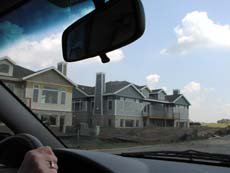index
About suburban sprawl
click on images for full-size:




New development outside Madison, Wisconsin

Maximizing real estate value

Protecting real estate value
Suburbs will continue to spread, and already a majority of people live in suburbia. So we have to both improve existing suburbs, and influence new construction, away from oversimplification and towards greater density of connection. -- This is pallid reformism. You should take the the long view and recommend stronger measures: draw urban growth boundaries; enforce mass transit; make suburbia tighten up into a more city-like density. -- This would demand a great deal of heavy-handed governmental action, and while that might work in many cases, there is too much growth to accommodate. Andres Duany is right that such policies might not be kept in place long enough to have their full desired effects. Besides, such attempts leave present suburban dwellers without any amelioration, for the sake of an imagined future total revolution. Most Americans may not want dense cities, but they might well prefer smaller yet denser nodes instead of what they are presently being offered. Sprawl can be improved by new kinds of spatial density but also other kinds of nearness and connection than spatial proximity. -- I appreciate your motivation, but aren't the very forces that created suburbia in the first place going to resist the kind of efforts you are speaking of? -- Yes, but we should be careful about making reductive explanations of sprawl described in a reductive way. There are many different forces at work, as is shown by the way sprawl is beginning to happen in Europe, even though Europe mostly avoided the governmental policies that encouraged postwar US sprawl.
- [Return to "the goal"]
- [Continue on the objections path]
- [Nearby: Objections and replies -- About themed places -- About landscapes and fields ]